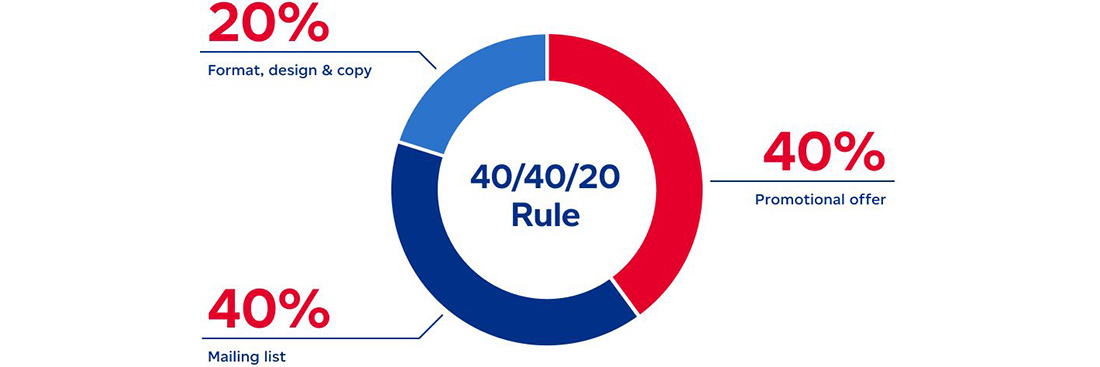in Direct Mail
Four rules for better direct mail results
By Canada Post
A precisely timed, well-written piece that has a clear and relevant message, with a compelling call to action, landing in the hands of the right person, is priceless. But how do you create a perfect piece that maximizes results? And are you using tools and tech to your full advantage?
Start with these four rules:
Rule 1. Know the 40-40-20 rule
This guideline breaks down which direct mail elements marketers should emphasize. Specifically, it says that 40 per cent of your efforts should be devoted to your audience, 40 per cent to the offer and 20 per cent to creative.

That means targeting the right people (your audience) is imperative. Use demographics, psychographics or location-based targeting to reach potential customers. The key is to deliver a message that’s tailor-made for your particular audience.
Your offer is equally important, so make it compelling and relevant to your audience. Tracking mechanisms — a phone number, URL or coupon code — help determine an offer’s success. They also let you calculate the return on investment of your campaign.
While audience and the offer are top priorities, don’t neglect the creative — it’s critical to success. Do the words and images convey the message you want to send? Does the design encourage interaction and inspire action? It needs to be strategically designed to get results.
Rule 2. Use formatting to your advantage
When it comes to direct mail shape and size, marketers have many choices. Each format has features and benefits that could work for you, depending on your particular campaign:
Self-mailers
A cost-effective and malleable form of direct mail, self-mailers require no need for an envelope, and creative can be produced in many shapes and sizes.
Outer envelope and letter
Include your pitch, announcement, offer or other message on the letter. A #10 envelope has a clear pane, so the name and address can be seen, which makes it ideal for personalizing your offer. The outside of the envelope provides more real estate for your message. Adding copy to this area also creates visual interest and will help your direct mail stand out.
Catalogues
Catalogues and mini-catalogues allow you to include more information than other direct mail options. Use them to tell your brand story and to describe products in detail. If you incorporate aspirational photography and inspiring content, a catalogue can enhance your brand’s experience and presence in customers’ homes and help re-engage lapsed customers.
Rule 3. Choose the right paper
Willow Printing Group can advise you about the best paper weights and colours for your direct mail campaigns. Different types of mail require different paper. For example, since postcards have no envelopes, the paper stock needs to be heavy enough to travel safely through mail sorting equipment. If you choose an outer envelope and letter combination for your campaign, you can opt for lighter paper because your message is protected by the envelope.
Catalogues and mini-catalogues have weight and size requirements, and you need to consider the binding as well. The binding is the part along the seam — will it be stapled or glued? Your answer will impact the paper you can use.
When it comes to outer envelopes and letters, paper colour lets you show a little personality by choosing a brand colour, for example, or something other than standard white. Colour also affects legibility; make sure there’s enough contrast between your paper and ink colours for the address to be read properly.
Rule 4. Tap into tools and tech
Easy to access, yet sophisticated, these innovative technologies have changed how you can respond to customer signals faster than ever.
Canada Post Programmatic Mail
Programmatic Mail is the physical equivalent of digital remarketing. Using customer insights, a brand can send someone a direct mail piece with a targeted message in as little as 48 hours.
Maybe a customer bought an item in store, interacted with your customer service hotline, abandoned a cart in your online store — or any of numerous possible interactions with your brand. Programmatic Mail allows your brand to leverage that interaction and quickly react to customer signals and triggers to get your messages into the right hands, at the right time.
QR codes
Technology has caught up with the QR code and marketers are finding lots of new ways to use them to connect with customers. Easy to scan directly from a smartphone camera and a welcome addition in a touchless world, these codes are popping up everywhere and are increasingly used by all age groups. QR codes are likely to play a key role as customer data magnets.
Predictive eye tracking
Before your marketing message can incite action, it must be seen. How do you know for sure key messages stand out? The data revealed by predictive eye tracking (PET) may be the answer. PET analysis software simulates human vision and can determine whether key areas of your mail piece are getting noticed. You can use these insights to reveal the effectiveness of your direct mail to predict and improve campaign response rates.
Keeping these four rules front of mind will offer you the confidence that comes from knowing that the time and energy you spend planning your next direct mail campaign will be focused in the right direction — and pointed toward success.

